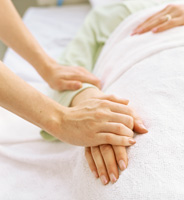One-Side Neglect


A stroke survivor may lack awareness of space on one side of the body. This is called “one-side” or “one-sided” neglect. The survivor does not “pay attention” to things on one side. The stroke survivor may not look, listen or make movements toward one side.
What Do You Need to Know?
One-side neglect is most common with strokes that happen on the brain’s right side. Strokes on the brain’s right side affect the left side of the body. The survivor often forgets or ignores the left side of the body.
Visual neglect affects the stroke survivor’s ability to see to one side. Objects and people on one side may go unnoticed. The survivor may miss food on one side of the plate.
Why Is It Important?
A survivor with one-side neglect may not be aware of the problem. This puts them at higher risk for injury. The survivor may run into walls or trip over furniture. They may not see someone approaching. Many survivors learn to adjust by turning their head toward the affected side.
What Treatments Should You Discuss with Your Healthcare Team?
In many cases, one-side neglect will get better within a few months after the stroke. Sometimes neglect lasts longer and relearning tasks is difficult. Treatment involves finding ways to increase the survivor’s attention to the neglected side.
- Occupational therapists and speech pathologists can provide tips and specific therapy.
- Physical therapists may suggest constraint-induced movement therapy (CIMT). CIMT involves restricting movement in the unaffected or “good” arm. This forces the use of the neglected arm.
- Orthoptists and Low Vision Specialists assess and provide therapy for visual neglect.
Helpful Tips
If your loved one has one-side neglect, try these tips:
Draw attention to the neglected side − Sit down next to the neglected side and talk to your loved one. This encourages him or her to look in your direction. Gently turn your loved one’s head toward you if needed. Touch or hold the neglected arm and hand.
Place objects on the neglected side − Place the TV remote or telephone on a table on the neglected side. This helps your loved one look and reach for objects on that side.
Guide the neglected hand when your loved one does daily tasks − Place the hand in your own and help guide it through the tasks.
Think about safety issues − Survivors with one-side neglect are at risk for injury. Remind your loved one to pay attention to things on the neglected side. Think about moving furniture and objects to prevent falls.
Remember
- Talk with your healthcare team. There are therapies that may be helpful.
- Focus attention on the neglected side. Place objects and talk on your loved one’s neglected side. Touch and hold your loved one’s neglected hand and arm.
- Think about safety issues. Survivors with one-side neglect are at high risk for falls.
More Resources 
Additional credible resources on this topic can be found here. Website pages may change or update, therefore if a link does not work, you may also try to type the information into your internet search bar. This Resource List will be updated frequently.
|
*Link Disclaimer: Links to information and Web sites outside of the Department of Veterans Affairs do not indicate an endorsement of products or services offered by the sites. In addition, these sites may have privacy and security policies that are inconsistent with those of VA. |
References: KY & S. Indiana Stroke Association. (n.d.). Life After Stroke: Survivor and Caregiver. Retrieved May 22, 2009, from: http://www.strokekyin.org/LifeAfterStroke.htm*; American Stroke Association. (2009). One-Side Neglect: Improving Awareness to Speed Recovery. Retrieved June 11, 2009, from: http://www.strokeassociation.org/*; National Stroke Association. (2009). Effects of Stroke. Retrieved June 12, 2009, from: http://www.stroke.org*; Eskes, G. and Benedict, D. (2006). What is Spatial Neglect? A Guide for Stroke Survivors and Their Families. Retrieved June 15, 2009, from: http://eskes.psychiatry.dal.ca/Files/WHAT_IS_NEGLECT.pdf*
These materials were created for the project:
Web-Based Informational Materials for Caregivers of Veterans Post-Stroke
Project Number SDP 06-327 funded by VA HSR&D Quality Enhancement Research Initiative (QUERI)



















